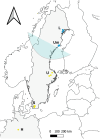Metamorphosis Reverses the Behavioral Phenotype in Rana arvalis Along a Latitudinal Gradient
- PMID: 40809828
- PMCID: PMC12344277
- DOI: 10.1002/ece3.71945
Metamorphosis Reverses the Behavioral Phenotype in Rana arvalis Along a Latitudinal Gradient
Abstract
Understanding how demographic processes and environmental conditions shape behavioral variation across populations is pivotal in evolutionary ecology. However, the role that such processes play in the link between behavior and life-history traits across populations remains largely unclear. The moor frog (Rana arvalis) has colonized Sweden via two distinct routes: from the south via Denmark and from the north via Finland. We collected R. arvalis eggs from multiple populations along a 1,700 km latitudinal gradient across Northern Europe and raised tadpoles in a common garden experiment. We assessed developmental growth and proactivity levels in ca. 300 individuals at two key stages of anuran larval development: tadpoles (Gosner stage 32) and froglets (Gosner stage 46). We found strong behavioral differences along the latitudinal gradient and between developmental stages. Tadpoles from northernmost populations were bolder (shorter time to leave a shelter) and showed higher activity levels in an open field test compared to those from southern populations. However, these behavioral patterns reversed at the froglet stage, individuals from northern populations showing reduced proactivity compared to those from southern populations. Further analyses indicated significant associations between developmental growth and boldness, with contrasting patterns across developmental stages and colonization routes. These findings support recent revisitations of the pace-of-life syndrome theory, emphasizing a decoupling of correlations between behavior and life-history traits across ontogeny, likely reflecting adaptive responses to divergent ecological and demographic constraints along the latitudinal gradient rather than a single fast-slow continuum.
© 2025 The Author(s). Ecology and Evolution published by British Ecological Society and John Wiley & Sons Ltd.
Conflict of interest statement
The authors declare no conflicts of interest.
Figures




Similar articles
-
Prescription of Controlled Substances: Benefits and Risks.2025 Jul 6. In: StatPearls [Internet]. Treasure Island (FL): StatPearls Publishing; 2025 Jan–. 2025 Jul 6. In: StatPearls [Internet]. Treasure Island (FL): StatPearls Publishing; 2025 Jan–. PMID: 30726003 Free Books & Documents.
-
Effects of parental care on skin microbial community composition in poison frogs.Elife. 2025 Jul 31;14:RP103331. doi: 10.7554/eLife.103331. Elife. 2025. PMID: 40742751 Free PMC article.
-
Maternal and neonatal outcomes of elective induction of labor.Evid Rep Technol Assess (Full Rep). 2009 Mar;(176):1-257. Evid Rep Technol Assess (Full Rep). 2009. PMID: 19408970 Free PMC article.
-
Regional cerebral blood flow single photon emission computed tomography for detection of Frontotemporal dementia in people with suspected dementia.Cochrane Database Syst Rev. 2015 Jun 23;2015(6):CD010896. doi: 10.1002/14651858.CD010896.pub2. Cochrane Database Syst Rev. 2015. PMID: 26102272 Free PMC article.
-
Short-Term Memory Impairment.2024 Jun 8. In: StatPearls [Internet]. Treasure Island (FL): StatPearls Publishing; 2025 Jan–. 2024 Jun 8. In: StatPearls [Internet]. Treasure Island (FL): StatPearls Publishing; 2025 Jan–. PMID: 31424720 Free Books & Documents.
References
-
- Alford, R. A. 1999. “Ecology: Resource Use, Competition, and Predation.” In Tadpoles: The Biology of Anuran Larvae, edited by McDiarmid R. W. and Altig R., 240–278. University of Chicago Press.
-
- Amat, I. , Desouhant E., Gomes E., Moreau J., and Monceau K.. 2018. “Insect Personality: What Can We Learn From Metamorphosis?” Current Opinion in Insect Science 27: 46–51. - PubMed
-
- Bakker, T. C. 1986. “Aggressiveness in Sticklebacks (Gasterosteus aculeatus L.): A Behaviour‐Genetic Study.” Behaviour 98: 1–144.
-
- Bates, D. , Maechler M., Bolker B., et al. 2015. “Package ‘lme4’.” Convergence 12, no. 1: 2.
Associated data
LinkOut - more resources
Full Text Sources

